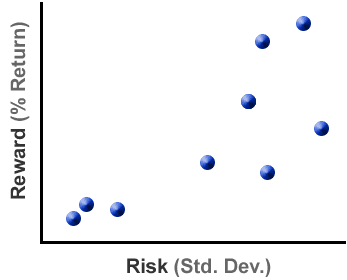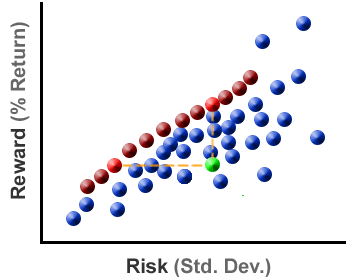 Building upon the idea of investing in broad markets, next up is Modern Portfolio Theory. This is another advanced topic that entire careers can be built around, but here is my attempt to explain it in one quick digestible chunk.
Building upon the idea of investing in broad markets, next up is Modern Portfolio Theory. This is another advanced topic that entire careers can be built around, but here is my attempt to explain it in one quick digestible chunk.
Risk vs. Reward
As far as investing goes, the most basic component we have is cash. If we invest it in a Treasury bill from the government (as riskless as possible), then we will end up with a return after inflation of zero. You just keep up with inflation. No risk, no reward. In order to increase our reward we, must take on more risk. But it’s not a linear relationship. We want to find the mix of investments that offer the best mix of risk and reward. So again we turn to history and whip up some math. (I’ll go easy on the numbers here.)
Reward = Return
The idea of reward is usually represented by the historical average annual return of the investment. Sounds good to me.
Risk = Standard Deviation
The idea of risk has many possible definitions. Stocks are seen as riskier as bonds, because their prices have historically fluctuated much more wildly. For example, for domestic stocks, your best year would be +39% while your worst year would be -28%. In contrast, for a broad bond portfolio, your best year would have been +31% while your worst year would be -8%. (Source: Vanguard) A mathematical way to measure this volatility is standard deviation. The larger the standard deviation, the higher the risk.
Mix ‘Em Up
An asset class is a group of investments that exhibit similar characteristics. If we plot their historical returns vs. historical standard deviations, we might get something like this:

One dot might be the S&P 500. Another dot might be 1-Year Treasury Bonds. Now, what if we starting mixing them up into in various ratios. Like taking 50% S&P 500, 25% US Small Cap, and 25% 5-Year Treasury Bonds. We’ll get a whole lot more dots, err… data points:

(Reference: IFA.com) The red dots form what is known as the Efficient Frontier. Why is it called that? Because it’s the only place you should want to be. 🙂 Take the bright green dot, which could represent any non-red dot. Why would you want to be at that mix of risk and return? You could simply
(A) move left on the chart to a red dot, where you get the same level of return, with much less risk, or
(B) move up on the chart to a red dot, where you get the same level of risk, but with much higher return.
Model Portfolios: Why Aren’t They All The Same?
Whenever you see a model asset allocation portfolio, chances are that they are constructed to be relatively “efficient” in terms of maximizing the reward/risk ratio. But if we take this theory above to the extreme, one could conclude that for each level of risk or return desired, there is one single, best portfolio mix. So why don’t we just figure that out and be done with it? The engineer in me wants that nice concrete answer.
Here are a few reasons why this is dangerous:
- The Efficient Frontier is based completely on the past. Again, should be expect the next 50 years to mirror the last 50 years? Correlations change. What are the fundamental factors that will persist, and how do we find them?
- The Efficient Frontier is always shifting. Every year there is new data, and the “ideal” portfolio changes. What was ideal in 1984 isn’t now. Do you try to predict the movement of the frontier as well?
- There are limitless asset classes, and investments to track such asset classes, to choose from. For example, some people regard Real Estate Investment Trusts (REITs) as an asset class, while others do not.
- “Real life” costs like management fees and commissions are not taken into account. For example, some asset classes like Emerging Markets cost more to own than others. Tax efficiency may also be important.
For each model portfolio, each creator must balance all of these concerns. Total agreement is rare, so all we can do is listen to each of their arguments and make our own decisions.
Read more: Index of Posts On Building My Portfolio
 The Best Credit Card Bonus Offers – March 2024
The Best Credit Card Bonus Offers – March 2024 Big List of Free Stocks from Brokerage Apps
Big List of Free Stocks from Brokerage Apps Best Interest Rates on Cash - March 2024
Best Interest Rates on Cash - March 2024 Free Credit Scores x 3 + Free Credit Monitoring
Free Credit Scores x 3 + Free Credit Monitoring Best No Fee 0% APR Balance Transfer Offers
Best No Fee 0% APR Balance Transfer Offers Little-Known Cellular Data Plans That Can Save Big Money
Little-Known Cellular Data Plans That Can Save Big Money How To Haggle Your Cable or Direct TV Bill
How To Haggle Your Cable or Direct TV Bill Big List of Free Consumer Data Reports (Credit, Rent, Work)
Big List of Free Consumer Data Reports (Credit, Rent, Work)
J: I think you didn’t mention the root reason of why this works. The reason is that the actual risk of a mixed portfolio is less than what one expects when asset classes are examined individually. For example, let’s say asset class A has a standard deviation of 20 and avg return of 15% and asset class B has a standard deviation of 10 and avg return of 8%. If you create a portfolio consisting of 1/2 of class A and 1/2 of class B your expected return would be 11.5% (1/2*15+1/2*8). Intuitively, you would think your standard deviation is 15 (1/2*10 + 1/2*20). Well it’s not – it’s actually less than 15. There’s the “efficiency” and why this is so wonderful.
i’m 20.. here is my 401k setup
TARGET RETIREMENT DATE FUNDS
BGI LifePath Fund 2045 25%
INDEX FUNDS
MSCI EM Free Index 50%
ACTIVELY MANAGED FUNDS
High Yield Bond 25%
Total 100%
Along the lines of risk vs reward, younger people can usually tolerate more risk because they have more TIME to let compounding take affect and those -20% years in the market will smooth out and become an 8-10 or whaterver % over the long term.
If you are in your 20’s, why would you own any bonds?
Granted everyone should be on the efficient frontier, but personally I would rather be on the upper right side of the red dots than the lower left side (if I understand this right). Maybe this is more due to someone?s general risk aversion? I’m 24 and when I see people my age putting money in cash or bonds, I wonder given the same time horizon I have (15-20 years), are there any good reasons for being so risk averse other than psychological. If so, overcoming those psychological barriers to tolerate more volatility would be to your advantage, right?
There are probably other factors that play into someone?s risk profile that smarter people than me might know about, any thoughts?
I’m also in my twenties, the reason I have anything in bonds is that I can take it out of my IRA penalty free for a home purchase one day. That might be soon. I think of it as tax advantaged home savings. I was really anti bonds for a while too. But I belive that bonds can reduce volatility by a lot without lowering returns that much. Also, they can make money in down markets, which is nice psychologically.
After reading William Bernstein I got really excited about the efficient frontier. It sounds great and the charts tell a nice story. You can spend hours running simulations and backtesting data.
However it is an illusion. The Intelligent Asset Allocator showed that a portfolio on the efficient frontier for one 20 year period was one of the worst portfolios you could have for the next 20 year period. There is no way to construct a portfolio that you know will be on the efficient frontier. You can make one that WAS, you can make one you PREDICT will be based on the past. The IFA stuff is very slick. The most important point I took away from Bernstein is the importance of allocation and how non-correlated asset classes can reduce overall risk and increase returns.
Good article, but personally I disagree with the Modern Portfolio Theory in it’s conception. As you might remember (or not) from some of my previous comments, I’m a big fan of Warren Buffett and believe in his approach to value investing. And according to Buffett, and many other renowned value investors, Modern Portfolio Theory suggests too much diversification which really limits your rewards potential even though the risk might not be decreased as much as you’d expect. Their approach is rather to concentrate on a dozen of stock that you spend significant time researching and understanding. By having a very good understanding where you’re investing – you reduce risk, you will wind up investing through a broad spectrum of industries (it’s not likely that all the great companies will be concentrated in one industry or sector) – and that will your diversification.
Of course, if you can’t evaluate companies or stocks as well as Buffett………….
CreativeInvestor: How have your returns been and how much time do you put into it?
Wes: To be honest with you, I’m speaking more from a theoretical belief than practical experience. I’m currently still learning and evaluate stocks based on the discounted cash flow model. So, I don’t have any returns to boast about at this time, only what you can see in my Marketocracy mutual funds, as I’ve posted on the blog yesterday. Currently, I put in between 2 and 8 hours a day analyzing stocks and reading business magazines, luckily I have some free time (for now).
The reason I’m so convinced of the value investing approach is because it makes perfect sense to me and people who practice it have something (a lot, actually) to show for it. The most astute and well-respected investors follow this approach in one respect or another. I don’t think you need to have Buffett’s genius mind to do it, he said that many times himself: you only need discipline and common sense.
Concur w/ Creative Vestor. MPT is academic dung, exploited by the money mgmt sector. “All these learned professors say you should fork your money over to us and we’ll take care of you through the miracle of asset allocation and risk management.” Learned professors also gifted us LTCM in 1998.
‘value investing’ is a redundant term; all legitimate investing is based upon purchasing assets at a discount to value. I admit that there is a hint of proper investing in the periodic rebalancing of one’s portfolio whereby over “weighted” asset classes are sold and under are bought. Still, there is a mechanical blindness to the margin of safety involved when rebalancing, and it’s that margin of safety which is the ultimate source of portfolio gains.
I’ll go more into correlation and stuff later. My goal was not to use any numbers at all this time around. Kind of succeeded 😀
You seem to invest very conservative. Why not just get an index fund or invest in some Chinese stocks with the help of Fool stock advisor? The returns will far outweigh the risk.
Current real inflation rate is about 8-10%. Don’t be fooled by government numbers. Oil up over 50% this year. Fed-EX raising prices 7% in January. My health insurance up 18% next month.
“all legitimate investing is based upon purchasing assets at a discount to value”
Well, no unless you just make up a definition for value. Surely you’d consider growth a legitimate investment strategy. Growth stocks usually aren’t considered value propositions. Momentum investing is probably an offshoot of growth investing and usually scoffs at discounted stocks.
I’m a big Buffett fan too. Who isn’t really! I totally agree with his theories about not over diversifying and finding great companies at cheap prices. Guaranteed winning combo. I also recognize that I will never do as good of a job as him at making such picks. Solution… invest in Berkshire Hathaway! Buy some brkb stock and you get to have Buffett make stock picks for you. I have a significant portion of my portfolio in this and it’s so fun to see it stay afloat when others are faltering. It’s like a mutual fund, due to the varying investments within Berkshire, but without the expenses.
Steve Austin really needs to study more before he calls MPT dung. Diversification is the only free lunch in investing…period. And, the men who devised MPT didn’t do so to help the money mangement business. They had no interest in it. They were professors. In fact, they advocate the opposite of what you get from money managers. Most money managers advocate the process of Creative Investor. All these money mangers claim they can find investments selling below their intrinsic value. The MPT gang says most investors can’t do this – at least not consistently. So you want to diversify, reduce expenses (think index funds) and minimize taxes. If you really want to read a good book on diversification and how it improves returns along with minimizing risk, you should read Roger Gibson’s books on investing.
Stephen, I certainly admit that value is subjective, so that by rule everyone either 1) “just makes up a definition for value” or 2) mindlessly accepts someone else’s definition of value. Growth and momentum may be strategies, but not of investment. Investment can also have multiple definitions as well; the one on which I have ruminated and to which I am partial is on p. 63 of the 2nd ed (1940) of Graham, Dodd *Security Analysis*: “An investment operation is one which, upon thorough analysis, promises safety of principal and a satisfactory return. Operations not meeting these requirements are speculative.”
Upstream Wealth, I regret my term dung — just a term that is fun to throw around for color. A more accurate word is probably bunk. To keep this comment below post-length, I’ll simply make a statement that I recall from MPT: returns on risky assets can be fully explained by volatility (beta, I guess they call it), which is another way of saying that the market is efficient (or at least not too inefficient). Bouts of fear and greed in marketplaces the world wide say to me that markets are not efficient because market players are not rational, or at least not so rational as to be the foundation for a theory on security behavior. Diversification is risky relative-return mediocrity, not safe outperformance.
I also wanted to clarify that I didn’t say that MPT professors colluded with money managers, only that money managers *exploit the reputation of academics* (the nebulous experts “they”) for their own (the mutual fund combine’s) profits. *Of course* money managers want you to believe what MPT professors say about how hard it is to find undervalued securities — money managers make easy money when people believe and pay them a % of your assets each year (regardless of how much they earn for those people, or how poorly that fund has done that year). Even with the seemingly trivial expense ratios of index funds, the industry makes far too much money off of passive surrender by shareholders to the concepts of diversification, efficient markets, and risk as nothing more than deviation from expected mean.
So….. sort of wondering how all you MPT bashers fared during the Great Recession. I can tell you from experience (I manage about 100 million dollars) that those who were using the efficient frontier – and moved leftward on the efficient frontier as the situation unfolded – fared FAR FAR better than those who were “focus”investing or doing that “Buffet-like” crap and “value investing” that you guys were talking about.
In fact – any of you still even there? Hello? Hello?
Yah… thought so. OK, back to the Efficient frontier. Oh, and BTW – no one says the Efficient Frontier or MPT has to be static. It is merely a guideline for controlling risk – not a predictor of the future.
My idea about risk & reward has changed considerably. Bonds currently do not strike me as a very safe investment unless you are in short terms or keeping the bonds till maturity. The idea should not be to die rich it should be not to die poor. Runaway inflation is probably the greatest thing we should fear. All safe investments become less valuable in that situation. Surprisingly after a dip stocks usually hold up much better than other investments.
If by chance the opposite happens it will turn out well for you if you are in a position to have money and things of value such as land.
Great article. Investors can also use the Diversset. It is a free web-based application that helps investors find great stocks and ETFs tailored to the investor’s risk appetite and builds an efficient investment portfolio using the Markowitz model and AI tools. Diversset suggests optimum asset allocation that will minimize the portfolio loss, maximizing the return. https://diversset.com